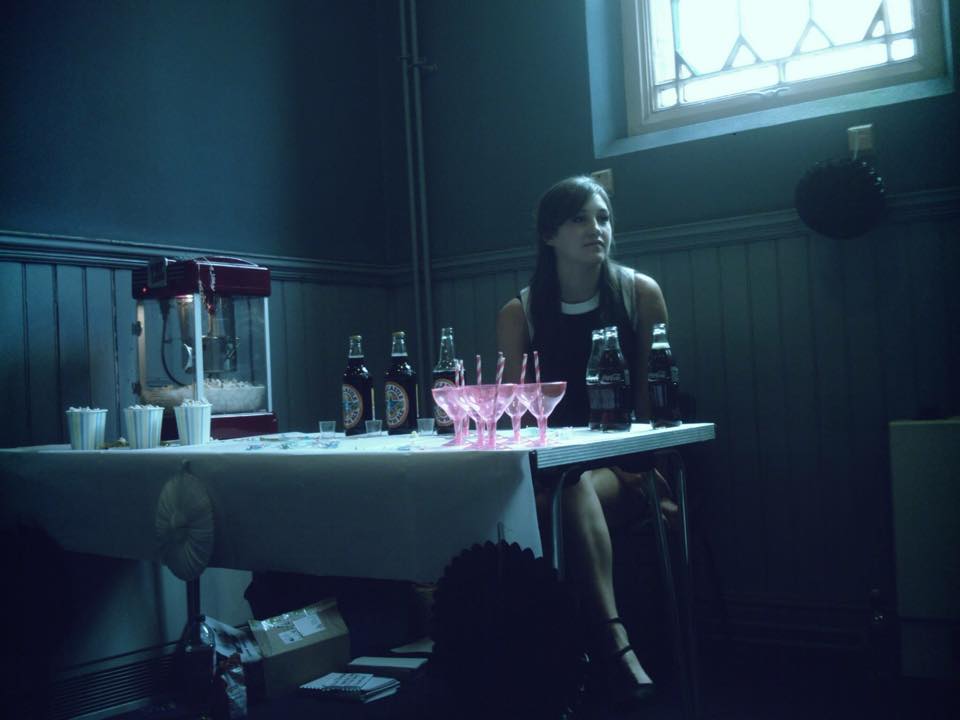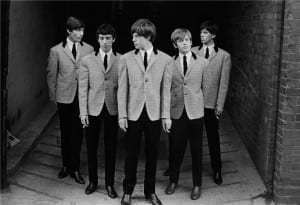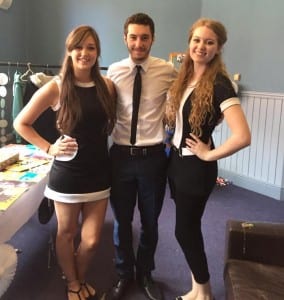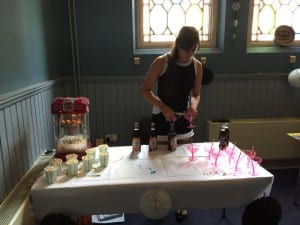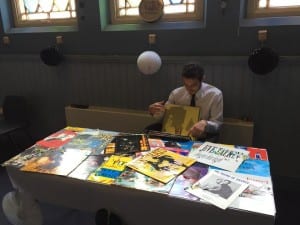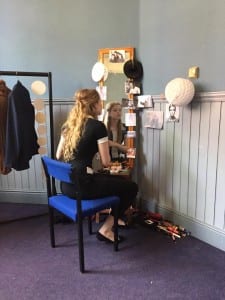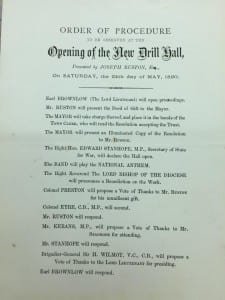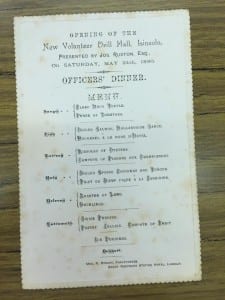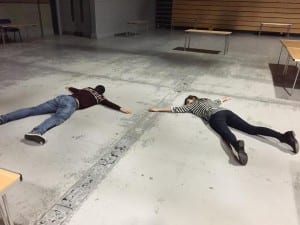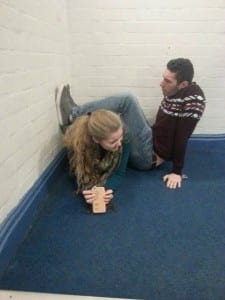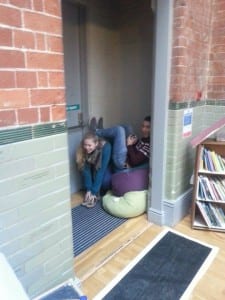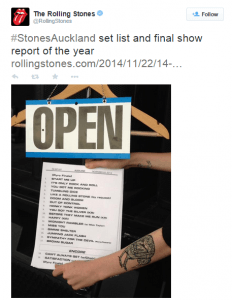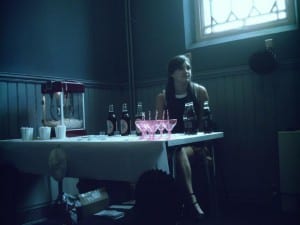Midnight Rambler
‘(Richard) Serra concluded simply and unequivocally that ‘to move the work is to destroy the work… to move the site-specific work is to re-place it, to make it something else’ (Kaye, 2000, 2)
This was the soundtrack to our performance, play this whilst reading to give you a taste of the sensory experience that our audience received…
https://www.youtube.com/watch?v=XhFbpUGteMQ (JimAdamsounds, 2011)
Framing Statement:
Since it’s opening on 24th May 1890, the Lincoln Drill Hall has had many varied uses such as a hospital during the typhoid epidemic, a military training centre for soldiers and as an armoury for the Lincolnshire battalions. My group and I felt that attention needed to be drawn to the more uplifting events that have taken place and so explored the Rolling Stones gig in 1963.
Our performance restored the hidden ‘Blue Room’ back to its former glory as the Lincoln Drill Hall box office on 31st December 1963, the New Years celebration that saw the up-and-coming Rolling Stones perform. Audience members turned up to our performance and were treated as Lincoln locals of the time hoping to get last minute tickets to the show at 11.48pm, they were then lead, three at a time, from the current box office through the auditorium and backstage into the small, secondary dressing room that is more often now used as a storage space.
Upon entering the room, the audience were greeted by sights, sounds and smells of the 1960’s, giving a true sensory experience. The room was filled with 60’s style decorations such as honeycomb balls and we were dressed in mini-dresses and a suit with our hair and makeup inspired by Twiggy and Brigitte Bardot. We had a recording of a live Rolling Stones performance in the early 1960’s playing in the background, alluding to the gig our whole performance was inspired by. The smell of the room was arguably the most overpowering as we had an authentic popcorn machine working throughout the performance, filling the room with the sweet aroma. We also offered each audience member popcorn and coca-cola in glass bottles, in-keeping with the time in order to engage their taste buds. Playing with the audiences senses was inspired by Curious’ piece ‘On the Scent’ which saw the audience making strong links between smell and memory, two themes running throughout our performance.
The concept of our performance was to educate the audience, in a very informal manner, about the night. The room was set up into three separate stations, representing the three people we found who attended the gig. My station was the refreshments stand because the story that I told was from Mick Fillingham, the drummer of the support act that night, who took the Stones to a nearby pub after the gig and introduced Mick Jagger to Newcastle Brown ale, which was then offered to the audience. Another station was drowning in vinyl records as the story told focused on the musicality of the gig. Then the last station was surrounded by makeup and hair tools, and photographs of famous icons of the time were stuck all around a mirror to resemble the story we heard from a lady about the fashion of the time, specifically the wire rings under the girls’ skirts that allowed them to jive all night long.
After telling these people’s stories for ten minutes, I left the room in order to try to squeeze the audience into the show before midnight. However there was never any ‘tickets available’ and so the three audience members were invited to countdown to midnight with us in the box office when we set off party poppers and wished them a ‘happy 1964!’ as they left the room and returned to reality.
Analysis of Process:
To begin our research into the history of the Drill Hall we took a trip to the Lincolnshire Archives which proved to be very insightful. My group and I found the Order of Procedures for the ceremony of the opening of the Lincoln Drill Hall. We also found an exact transcript of the speeches given, the leading members of the community who attended and a precise detailing of everything that happened on the day. This gave us the perfect tools to be able to create a piece almost perfectly recreating the ceremony.
We took inspiration for this idea from artists Iain Forsyth and Jane Pollard who ‘initially became known for pioneering the use of re-enactment within contemporary visual art.’ (Iain and Jane, 2015) This artist couple recreated musical events such as David Bowie’s farewell performance as Ziggy Stardust; they were praised for their extreme attention to detail and their true commitment to ensuring every aspect of the performance matched the original perfectly. ‘A Rock ‘N’ Roll Suicide’ sold out two nights at London’s Hammersmith Odeon on 2nd and 3rd of July, exactly 25 years to the day of Bowie’s original concert.
Whilst we were in awe of Forsyth and Pollard’s dedication to the exact re-enactment, we decided we wanted to instead blur the distinction between 1890 and 2015 as a way of paying tribute to the journey the Drill Hall had gone through in the 125 years of it being open and how much was achieved in the building. I also felt that it was important to acknowledge the Drill Hall site as it stands today and not simply focus on its history. As the performance that we devised and the building in its current state will soon be part of its history as well. ‘Performance may become an active agency of archaeology: demonstrating for the popular imagination how we ourselves, and our immediate environment, are part of a historical process; how constituents of material culture exist within overlapping frames and trajectories of time’ (Pearson, 2010, 169). With this in mind, our idea was to juxtapose original elements of the ceremony with current features of the business today. For example, we would serve the audience dinner on grand silver platters, such as they would have done in 1890, but open the lids to reveal simple sandwiches and bottles of Coca-Cola sold in the Drill Hall café today.
However we soon discovered that we could not realistically achieve this idea with as much accuracy as we wanted for the piece to be effective due to time and budget restraints. Yet we had really been engaged by Forsyth and Pollard’s work and also still wished to pursue the juxtaposition of time frames. This is when we decided on using the Rolling Stones gig as stimuli and our idea progressively developed from there. Our initial idea was then to recreate the December 1963 gig, in keeping with ‘A Rock ‘N’ Roll Suicide’, whilst having modern elements to the performance such as using modern equipment. But we found yet again we were met with stumbling blocks difficult to overcome with the resources available to us.
We decided to do some more research into site-specific artists and their work and when we had found a few we all engaged with we returned to the Drill Hall to discover a place that inspired us. We took part in an exercise called ‘Noticing Unnoticed Spaces’ in which we had to explore the Drill Hall in more detail and create shapes with our bodies to fill an ‘unnoticed space’ then we had to recreate that shape elsewhere and notice the differences. On this journey we discovered a hidden room backstage called the ‘Blue Room’ which is sometimes used as a changing room as an overspill from the main dressing room (the ‘Green Room’) for visiting performers but is more often used as a storage room for extra furniture. We were immediately drawn to this room because it appeared to be too grand for a store room, and upon further research we learned that it was in fact once the box office for the Drill Hall as the whole building had been turned around so that the large front doors were now the seldom used back doors.
After this great discovery our ideas all came together very easily, with inspirations from Janet Cardiff, Curious and Iain Forsyth and Jane Pollard we would partially recreate the 1960’s box office on the night of the Rolling Stones gig and we would throw the audience into a sensory yet informative experience that blurred distinctions between the past and present. We found several people who attended the gig and collated their memories of the night, mapping out the events of the night through their stories until our performance became a ‘purposeful assemblage of fragments created elsewhere, at some other time, from viewpoints unavailable to the audience’ (Pearson, 2010, 154).
Janet Cardiff’s Forests became a huge inspiration to our piece; we were especially interested by the way she disrupts the senses by blurring the lines between reality and performance in the forests. Often during her piece the natural sounds in the forests could be heard over the audio track being played through speakers, confusing the audience. We hoped to recreate that disruption of the senses in our performance with the 1963/2015 crossover as we would never be clear with the audience which time frame we were speaking in.
Much like Janet Cardiff we also wanted to force the audience to be aware of their own reactions as they were visible to us and each other. Cardiff did this in Forests as the audience entered a clearing in the woodland and had the freedom to position themselves sporadically around the space. As said by Paul Allain and Jen Harvie, ‘there clearly exist(s) many different understandings about what audiences do, and especially about whether audience participation is fundamentally active or passive.’ (Allain and Harvie, 2006, 133) We would do this by encouraging the audience to get involved with the piece if they wished; we would ask questions about the Rolling Stones and about the sixties. We would also offer them food and drink and have very informal conversations with them, injecting a friendly atmosphere into the performance in order for the 3 audience members to feel comfortable with us as members of the public would have done if they had visited the Drill Hall box office in 1963.
We were also fascinated by Curious’ performance ‘On the Scent’ and how it ‘explores the elusive connections between smell and memory’ (Curious, 2004). The four audience members enter a house where they are taken on a journey through the rooms, meeting three very different performers who give off different scents. We wanted to bombard the audience with familiar smells as soon as they entered the room in order to evoke past memories and emotions as they experience the performance, hence our use of a real popcorn machine. Memory can be powerful and we wanted much of our piece to be reminiscent for the audience, whether they were old enough to remember the sixties or not. Site Specific art is often based on the history of a place and therefore it was an appropriate medium to recreate that night at the Drill Hall. ‘Site-specific can be especially powerful…as a potent mnemonic trigger, helping to evoke past times’ (Pearson, 2010, 9)
An important theme that emerged throughout our process of development was the number 12. This initially stemmed from the fact that the gig was held on New Years Eve and so we had wanted to recreate that feeling of celebration s and excitement for our audience, to do this we decided that the time during each performance should be close to midnight. Originally we had the clock starting at 10 o’ clock at the beginning of our 2 hour performance time so that our last performance would end at ‘midnight’ and we could chant the countdown and celebrate the coming of 1964 with the last audience. However we decided against this in order for every audience to feel the same level of excitement, additionally this would have meant the build up to midnight would only have been felt by us as the audience were not present for the whole two hours we were performing for. Instead we set the clock to 11.48pm, making our performance running time 12 minutes long.
Additionally we ideally wanted the title of our performance to be the name of a Rolling Stones song, in keeping with Iain Forsyth and Jane Pollard’s ‘A Rock N Roll Suicide’. We liked the sound of ‘Time Is on My Side’ yet the song ‘Midnight Rambler’ fit our piece perfectly. I also researched the Rolling Stones’ recent performances and found that on their most recent tour in 2014 ’14 On Fire’ the band played their song ‘Midnight Rambler’ 12th on the set list.
Towards the end of the process, once we had collated the stories and formed our performance we noticed that we were having great difficulty with the timing of the piece. We had decided the duration should be 12 minutes to reference the theme running throughout, however because we had chosen to use an informal, conversational style of performance we were relying heavily on responses from the audience. This would mean that the piece would change slightly every time and therefore exact timings became difficult to ascertain. I suggested to the group that we all do further research into the early 1960’s, 1963 in particular; so that we could discuss current affairs of the time should we not have a particularly vocal audience. This lead to us devising a short section that included information about the Kennedy assassination and the recently released ‘From Russia with Love’ film. We would then be able to engage even the quietest of audience members in a conversation as we discussed opinions on the film and chatted informally about how one of our cast members, Sean Micallef, thought of himself as being similar to James Bond with Ladies.
Mike Pearson sets out that there are three types of relationship within performance – ‘performer/performer, performer/spectator (and) spectator/spectator’ (Pearson, 2010, 175). In our piece we aimed to blur the lines of the performer to spectator relationship by inviting the audience to be an active feature and allowing them freedom to move and speak as they wished whilst we, as performers, still had control of the performance. We did not treat each audience member as a detached observer but as a companion. The informality of our performance created a very relaxed atmosphere as we spoke with the small audience in the way one would speak to a friend in an everyday conversation. We became acutely aware that our audience would be ‘cast as participants, ‘co-creators’ of the work. The demands upon them to contribute material are substantial’ (Pearson, 2010, 178)
Performance Evaluation:
As a great part of our performance was reliant upon audience reactions it was interesting to hear their feedback once the performance was finished. There was a wide variety of responses to our conversational style piece, many audience members spoke comfortably with us about the topics, answering questions in detail and often telling us their own stories in return. Including one elderly gentleman who remembered being at the Drill Hall for a different gig when the building was back to front to the way it is laid out now. One younger man told us afterwards that he felt uncomfortable in parts of the performance as he was not certain whether he should ‘play along’ with the façade of being in 1963. This was interesting to hear yet pleased me as it proved that we had achieved our intention to truly blur the distinctions between the time periods by disrupting the senses, like Janet Cardiff.
More often than not we had two audience members at a time instead of the intended three, this did not appear to have much of an impact on the performance as this simply meant that the spectators were given a more personal experience without feeling intimidated or vulnerable because they were able to rely on each other for reassurance of how to react or respond.
If we were to perform our piece again the main thing I would alter would be the entrance of the audience. This is because I was tasked with collecting our audience from the current box office and escorting them through the length of the building to our site. Whilst this gave me the opportunity to visually describe how the Drill Hall was laid out on the night of the gig I felt that the façade of 1963 was broken too early in the piece. I would have the audience beginning by entering through the old front door to the building, experiencing our performance and then at the end of the piece I would escort them to the current box office. In this way the performance would begin in the original 1960’s setting and end in 2015.
Our research into Site-Specific performances has enabled me to view the performer/spectator relationship in a new light as I now understand that an audience can do more than observe, they can in fact help build and create a piece, and be unaware that they are doing so. It has also allowed me to view a performance site as more than just a stage but as an explorative method of learning.
‘Although the stage is a site of imagination and site always inescapably itself, site may be transformed by the disruptive presence of performance seeking a relationship other than that of a ready-made scenic backdrop against which to place its figures.’ (Pearson, 2010, 2)
Works Cited:
Allain, P. and Harvie, J. (2006) The Routledge Companion to Theatre and Performance. New York: Routledge
Curious (2004) On the Scent [online] Available from http://www.placelessness.com/project/1121/on-the-scent [Accessed 10 May 2015].
Fage, C., Harris, M. and Micallef, S. (2015) Midnight Rambler. [Performance] Lincoln: Lincoln Drill Hall, 8th May.
Iain and Jane (2015) Biography. [online] London: Available from http://www.iainandjane.com/about/biography/ [Accessed 10 May 2015]
JimAdamsounds (2011) The Rolling Stones in Concert 1964 [online video] Available from https://www.youtube.com/watch?v=XhFbpUGteMQ [Accessed 11 May 2015].
Kaye, N. (2000) Site-Specific Art: Performance, Place and Documentation. London: Routledge
Pearson, M. (2010) Site-Specific Performance. Basingstoke: Palgrave Macmillan
Pearson, M (2010) Site Specific Theatre. Hampshire: Palgrave Macmillan
RollingStones (2014) The Rolling Stones release their set list on their ’14 On Fire’ tour. [Twitter] 22 November. Available from https://twitter.com/RollingStones/status/536122544504332288/photo/1 [Accessed 26 March 2015]
Townsend, P. Photographers Gallery. Available from https://www.photographersgallery.com/photo.asp?id=3108 [Accessed 14 May 2015]
